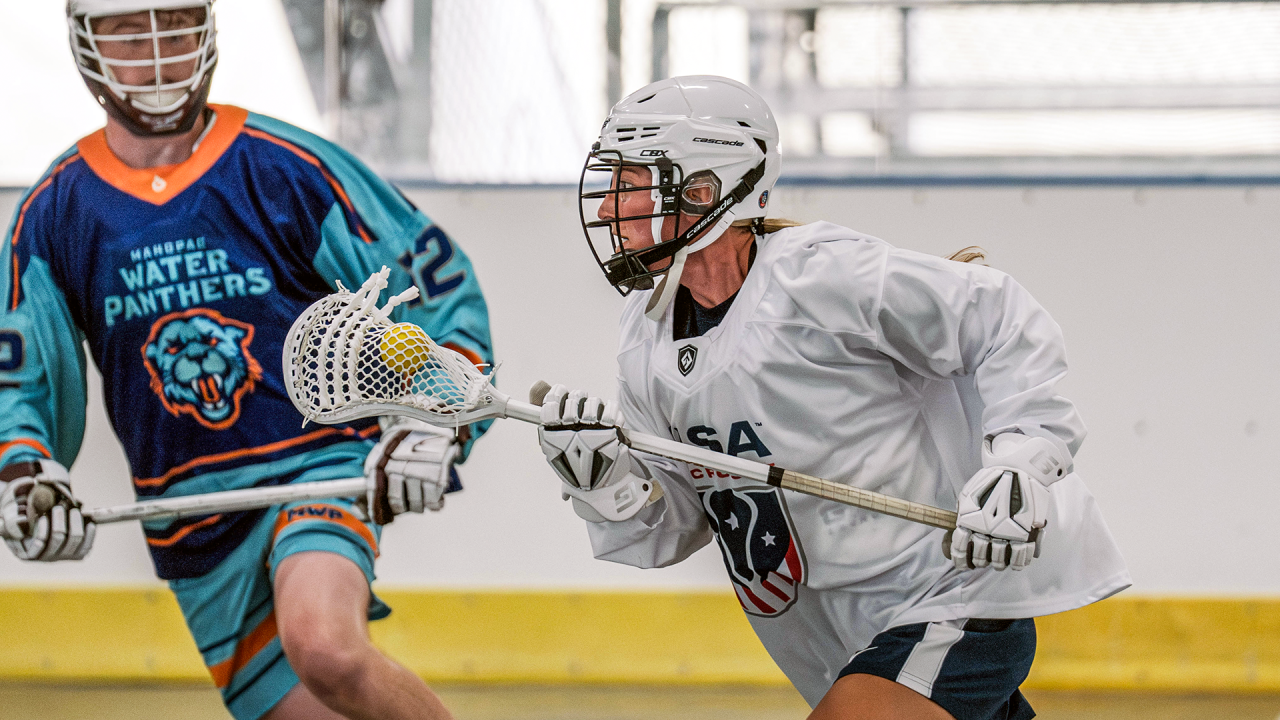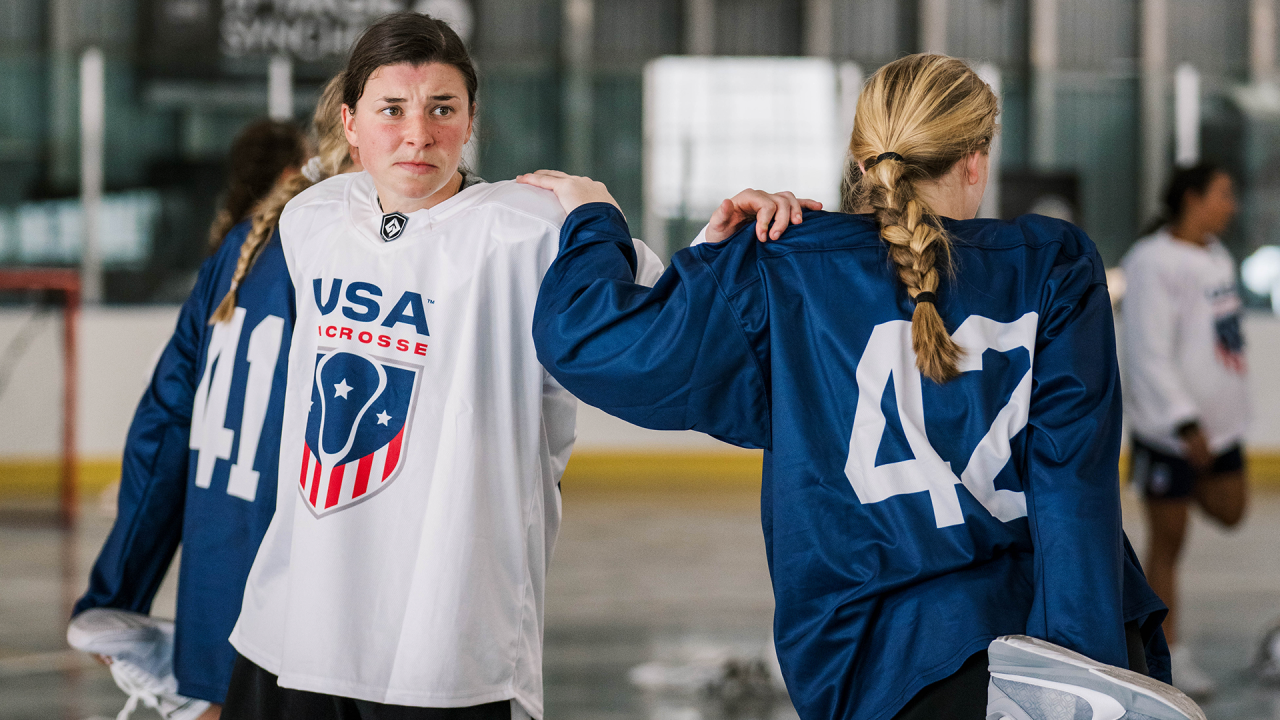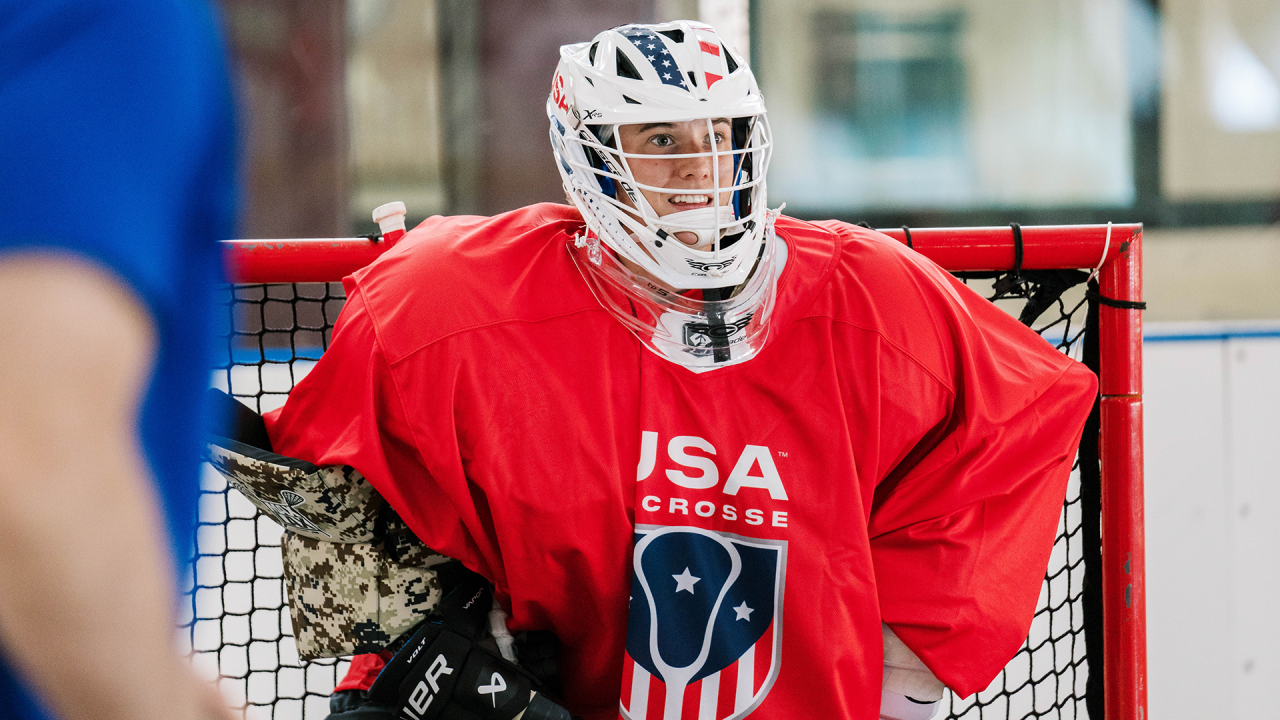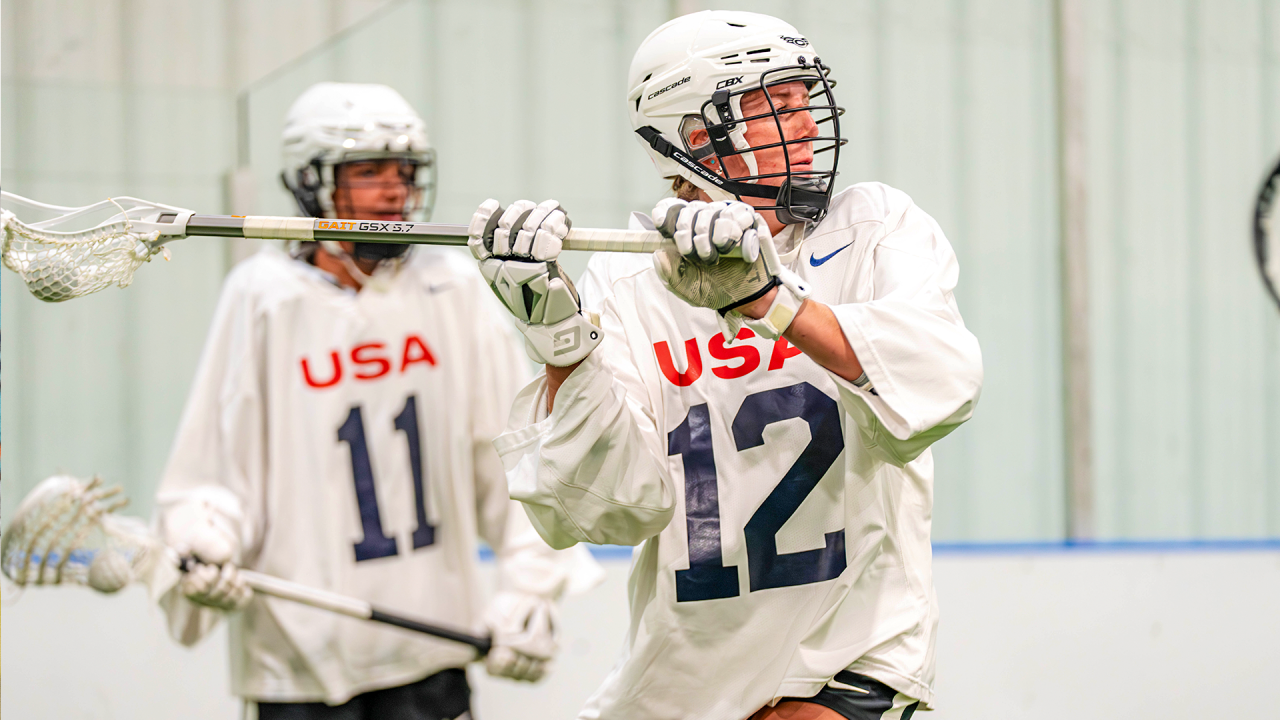
Don't Box Them In: U.S. Women Embrace New Discipline
Ally Kennedy, Ally Mastroianni, Taylor Moreno and Charlotte North have absolutely nothing left to prove in lacrosse. All four are champions. Kennedy, North and Mastroianni were part of the 2022 U.S. Women’s National Team that won a world title. Mastroianni won an NCAA championship. So did Moreno, the two-time Athletes Unlimited champion. North also led Boston College to its first NCAA crown in 2021.
But all four women’s lacrosse stars decided to throw on pads and try out for Team One, the inaugural U.S. Women’s Box National Team that will vie for gold at the 2024 World Lacrosse Box Championships later this month in Utica, N.Y.
As all four quickly learned, box is a whole new ball game.
“It was like nothing that I've accomplished in field lacrosse mattered, and that goes for all of us,” said Kennedy, a 2022 Stony Brook graduate. “It’s like learning a whole new sport.”
That was part of the fun.
Kennedy, Mastroianni, Moreno and North discussed the most significant differences and how they overcame them. Most importantly, they explained why they threw their helmets into the arena and kept pushing.

A NEW IQ
Step one for Team One? Forget (almost) everything you know.
That leaves room for an open mind.
“Understanding different types of two-player games, picks and rolls, manipulating the defenses, deceiving a goalie — it is similar to an extent, but it's very different in the indoor game,” North said. “We had to understand that we can't rely too heavily on what we do in the field game and be willing to adapt and change your game.”
Mastroianni knew that from the get-go.
“Box expands your lacrosse IQ, and it emphasized a lot of the parts of my game that I wanted to work on,” Mastroianni said. “Box requires the opposite of my strengths in field — the small spaces, the quick little movements. In field, I'm used to the longer field and lots of space to dodge. I saw it as a challenge.”
FINDING A LANE
One reason North and Kennedy quickly developed an entirely different lacrosse IQ is that they had to develop new offensive strategies to adjust to the nuances of box lacrosse. The goalies are in pads, and they occupy a smaller space. Box goals are 4 feet, 9 inches wide, and 4 feet high. Field goals are 6 feet tall and wide, 7 feet deep.
“It’s a different skill set to score and generate a strong offense,” North said.
North knows a thing or 300 about generating an offense. She graduated as the all-time leader in NCAA Division I women’s lacrosse with 358 career goals and led the U.S. with 23 goals in 2022. Her range and hard, fast shots are the stuff of YouTube lore. Even soccer great Abby Wambach is a fan.
Kennedy, who poured in 266 goals at Stony Brook, had to re-learn how to approach scoring and passing. When someone slides low-to-high in field, you can count on Kennedy to pass the ball to the low attacker, even if they are on goal line extended.
U.S. head coach Ginny Capicchioni, who broke gender barriers when she played goalie in the National Lacrosse League in 2003 and for the U.S. Men’s Box National Team in 2011, emphasized these nuances during player ID and training camps — the last of which is this weekend in Baltimore.
“I had to learn to be able to shoot over and around a defender and not necessarily always making that one more pass to someone lower than me,” Kennedy said. “In box, they have a harder angle to shoot from because the goal is much smaller, and the goalie has so much more equipment. The goalie can just move and hold the pipe. She's taking up 80 percent of the cage, and there's not a lot of goal left for that attacker to shoot.”
Footwork also factors.
“A big thing that I'm personally working on is, in field, we love to sweep and shoot with our feet on the move,” Kennedy said. “In box, something Coach Cap has been trying to get into my head is that when I have a lane to shoot, I can fully stop and step into my shot and not necessarily sweep across the whole floor.”

ALL THAT EQUIPMENT
Pads may help a goalie take up more space, but Moreno said it wasn’t an immediate advantage. It took getting used to. Offensive and defensive players also wear pads, and North mentioned it as a key early adjustment.
“Being in all that equipment is probably the biggest challenge,” Moreno said. “It was uncomfortable at first. The movements are completely different.”
Moreno and North had to trust the coaches — that playing lacrosse was supposed to feel this way.
“It was about spending time breaking in the equipment like you would break in a stick,” Moreno said. “A lot of the time, goalies practice and wear equipment that has been severely broken in, whereas a lot of the stuff we're getting now is just brand new, so it was stiff.”
Besides the pads, Moreno had to get used to another piece of equipment: gloves. And not just the feeling. They affected how she could use her stick. Unlike in field, she had to get used to keeping the stick between her legs rather than above her head.
“Since I’m wearing gloves that are ginormous compared to what I wear in the field game, the hand positioning of the stick is completely different,” Moreno said. “It was certainly an uncomfortable position to be in. It was like, ‘I swear, I know how to throw a ball, but it doesn't feel the same way.’”
She credits Capicchioni for helping her adjust her stance.
“She’s helped me work through where my hand is positioned to make sure that I'm still able to move my shoulders and block balls with that same arm that's holding the stick,” Moreno said. “But she’s also helped me become so versatile with my stick so that I can easily clamp the ball and transition into a clear if I need to.”
In college, that was Moreno’s bread and butter. She was an active, athletic goalie, sometimes completing half the battle for the offense by running the ball up the midfield.
While not quite the case with box, “We’ve progressed through the training camps, and I am more comfortable with it,” she said.
PHYSICALITY AND PACE
There’s a reason for the pads: The box game is physical and fast, two aspects that drew one of the greatest field attackers ever to pick up a stick to give box a go.
“I've always watched it from afar and been a fan of the NLL and the men's international teams,” North said. “It’s exciting and fast-paced but physical and tactical.”
How has she adjusted? If you’re here for rocket science, we’re sorry.
“The more we've been working and training together, the better it's been,” North said. “Handling the physicality and allowing each other to unlock that part of our game, the physical aspect, has been a fun experience.”
For goalies, too.
“In box, you're covering up the majority of the cage, but you're still obviously leaving certain areas open,” Moreno said. “You have to understand what you're leaving open to anticipate — in certain scenarios — where shots might be gelling. At the end of the day, you end up having to rely purely on your reactionary tactics. Box puts you in a unique position where you're using your body for 95 percent of the saves.”
This brings Moreno to her next point — one that each player spoke about. The box game is faster. The IQ needs to feel like second nature, and failure must be forgotten almost before it happens.
“Getting scored on periods sucks, but there’s an understanding that you're going to be able to continuously keep yourself in a rhythm, unlike in field where you have those bigger gaps of rest when the ball is on the other end in field,” Moreno said. “Because it’s so fast-paced, you don't get an opportunity to reminisce about the goal that was just scored on you. It’s this goldfish, move-on mentality.”
For what it’s worth, the offensive player has been assigned a similar rush job.
“Every second that you're on the floor, you're doing something,” Mastroianni said. “You're creating space for someone else or for yourself. You're thinking five plays ahead because the ball moves so fast, and you have to make quick decisions.”

BETTER FOR FIELD
Box may be an entirely different discipline, but all four U.S. standouts say it’s made them better field players. North, Kennedy, Mastroianni and Moreno finished top five on the Athletes Unlimited leaderboard this summer.
“I'm a dodger,” Kennedy said. “I don't really cut. I'm not an inside player. I’m more of a 1v1 player — beat my defender and hopefully score. This season, I've probably scored more off-ball goals by catching and receiving on the inside and finishing. That is all a credit to box because I’m setting picks, rolling off them and moving into open space. I have my stick a little more choked up, so anytime a pass is near me, I have quick hands to grab it, take a second, see the goalie and shoot around them.”
Moreno feels like she’s made more body saves, but the most significant difference is in her anticipation.
“I can read the moment and anticipate where the ball might be swinging to or where the shot might be coming from,” Moreno said. “Box has taught me about being prepared and ready for that shot, and just honoring shooters and my positioning in the case and trusting my ability to read and save a shot.”
A MINDSET AND A MOVEMENT
All four women have had to shift their games and skillsets to compete for a spot on the final roster. But they also want to shift the mindset of who can play box — not just Canadians and not just men.
Let’s start with Mastrionni, who joined a men’s league in New Jersey to hone her skills and is grateful for their insights. She’s also studied Tom Schreiber, one of the best American-born players ever to play in the NLL.
“He is absolutely incredible in field lacrosse and in box lacrosse, and I've actually had the honor to work with him a little bit,” Mastroianni said of Schreiber, who has played on four U.S. teams across disciplines but will miss the upcoming box championships due to a fracture clavicle sustained last month in the Premier Lacrosse League. “He lives in my town in Jersey, so sometimes when I do my training sessions I share the field with him. I was a little starstruck the first time I met him, and then I watched him play, and he was just unbelievable.”
Young girls get starstruck when they meet Mastrionni. But one of her goals is to make box lacrosse relatable for them and show them they can grow their games by trying it.
“I wish I had some of these tools and this IQ at a younger age,” Mastroianni said. “It's also fun.”
Speaking of fun, watching Lyle Thompson was a spectator sport for North while growing up in Texas.
“He’s so creative, North said. “He does a good job of feeling defenders’ pressure, reading it and adapting to it. He’s extremely deceptive in subtle ways with his stick and his body. I’ve watched so many of his games and highlights of him playing and trying to emulate things that he does.”
Now North has set out to create some of her own highlights with Team One, adding to her YouTube library.
“I remember being young and obsessed with just about every discipline all across lacrosse,” North said. “But especially for box, women just didn’t have an opportunity to play it. We hope that it sparks more box leagues around the world. We hope it sparks more of a youth box movement and allows for more opportunities for young girls to train in indoor discipline if they want to.”
Beth Ann Mayer
Beth Ann Mayer is a Long Island-based writer. She joined USA Lacrosse in 2022 after freelancing for Inside Lacrosse for five years. She first began covering the game as a student at Syracuse. When she's not writing, you can find her wrangling her husband, two children and surplus of pets.

Categories
Related Articles




